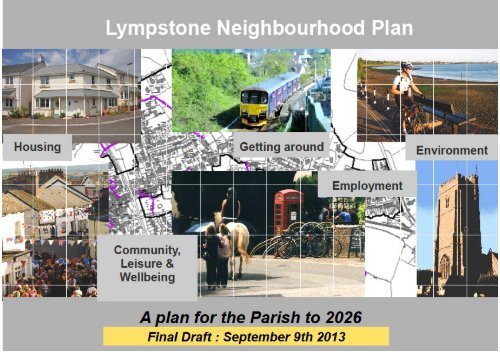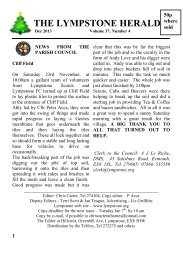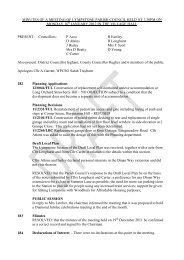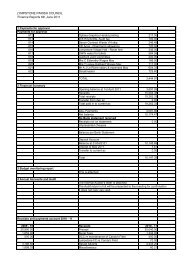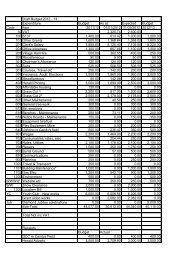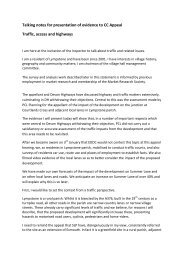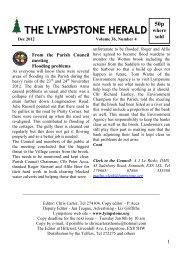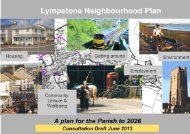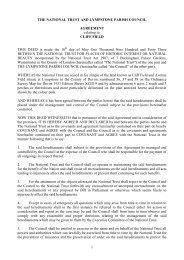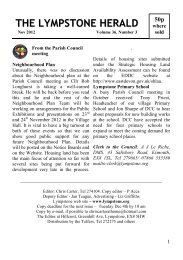Lympstone Neighbourhood Plan Final Draft - Lympstone Village ...
Lympstone Neighbourhood Plan Final Draft - Lympstone Village ...
Lympstone Neighbourhood Plan Final Draft - Lympstone Village ...
You also want an ePaper? Increase the reach of your titles
YUMPU automatically turns print PDFs into web optimized ePapers that Google loves.
<strong>Lympstone</strong> <strong>Neighbourhood</strong> <strong>Plan</strong> — <strong>Final</strong> <strong>Draft</strong> — 9 th September 20131. Introduction1.1 The <strong>Lympstone</strong> <strong>Neighbourhood</strong> <strong>Plan</strong> (The <strong>Plan</strong>) is a new type of planningdocument. It is part of the Government’s new approach to planning, whichaims to give local people more say about what goes on in their area. This isset out in the Localism Act that came into force in April 2012.1.2 The <strong>Plan</strong> provides a vision for the future of the community, and sets outclear planning policies to realise this vision. These policies accord withhigher level planning policy, as required by the Localism Act.1.3 The <strong>Plan</strong> has been developed through extensive consultation with thepeople of <strong>Lympstone</strong> and others with an interest in the parish and is basedon sound research and evidence. Details of the consultation have beenrecorded in a series of reports and an overall ‘Consultation Statement’, allof which are available to download from the <strong>Lympstone</strong> website(www.lympstone.org). This ensures that the <strong>Plan</strong> meets Regulation 14 ofthe <strong>Neighbourhood</strong> <strong>Plan</strong>ning (General) Regulations 2012. A summary of theconsultation is appended to this <strong>Plan</strong>.How the <strong>Neighbourhood</strong> <strong>Plan</strong> fits into the <strong>Plan</strong>ning System1.4 The Government’s intention is for local people to decide what type ofdevelopment they want to see in their area. The proposals must be in linewith national policy as set out in the National <strong>Plan</strong>ning Policy Framework(NPPF) and the strategic policies of the East Devon Local <strong>Plan</strong>. Importantlythe <strong>Draft</strong> Local <strong>Plan</strong> requires the provision of a minimum of 40 new homesin <strong>Lympstone</strong> by 2026.1.5 The Localism Act allows The <strong>Plan</strong> to provide more than this number ofhouses but it does not allow The <strong>Plan</strong> to provide for fewer.1.6 <strong>Neighbourhood</strong> <strong>Plan</strong>s must be in line with European Regulations onstrategic environmental assessment and habitat regulations.1.7 The <strong>Plan</strong> has given local people the power to decide where new housingand employment development should go, and how the parish shouldchange. WithoutThe <strong>Plan</strong>, East Devon District Council would make these decisions withmuch less local input.What is in the <strong>Neighbourhood</strong> <strong>Plan</strong>?1.8 Although deciding where new housing and new employment should go isan important part of the <strong>Plan</strong>, it is about much more than this. The <strong>Plan</strong> isa plan for the parish as a whole. It looks at a wide range of issues, otherneighbourhood plans have included: whether a new community facility is needed and where it shouldgo how walking and cycling around the parish should be improved provision for home working to meet 21 st C needs what open space new housing should contribute to the parish encouraging the community to become a ‘greener’ and moresustaining.Deciding <strong>Plan</strong>ning Applications1.9 The Local <strong>Plan</strong> includes a number of ‘Development Management’ policieswhich are used to determine planning applications. These will continue toapply to new development in <strong>Lympstone</strong> but the <strong>Neighbourhood</strong> <strong>Plan</strong> addsimportant local detail to those policies which are particularly significant tothe character of our community. For this reason the <strong>Plan</strong> emphasises theneed to retain and enhance the natural environment and recreationalopportunities, and the importance of good design. It should be read inconjunction with the <strong>Village</strong> Design Statement.Improving the Quality of Life in our community1.10 The <strong>Neighbourhood</strong> <strong>Plan</strong> also includes a number of local policies/aims toimprove the quality of life in the Parish – these are Community Action <strong>Plan</strong>s(CAP) which will be used by the Local Authorities in reaching decisions.Based on extensive research, these actions will ensure that decisions arereached in the best interest of local people.Page 3
<strong>Lympstone</strong> <strong>Neighbourhood</strong> <strong>Plan</strong> — <strong>Final</strong> <strong>Draft</strong> — 9 th September 20132. The Content & MethodologyThe <strong>Neighbourhood</strong>2.1 <strong>Lympstone</strong> is more than a <strong>Village</strong> – it is a Parish. In developing this plan it isinevitable that much of it will deal with the <strong>Village</strong> of <strong>Lympstone</strong> where theconcentration of people and issues lies, but it is important to include UpperHulham Road, Higher <strong>Lympstone</strong>, Courtlands Lane and Sowden; all parts ofour Community and all part of our <strong>Neighbourhood</strong>. So the <strong>Neighbourhood</strong>is The Parish of <strong>Lympstone</strong> as shown on Map 1.Our geographical setting is both a Constraint and an Opportunity. Aconstraint that we are a triangle of a parish bounded on the western flatside by the river Exe; we are geographically a small parish; our ability toexpand is limited. But likewise the Green Wedge and Coastal Protectionstatus to our southern boundary give us protection from coalescence withExmouth and is an opportunity for us to retain our community identity andway of life.In developing our <strong>Plan</strong>, however, we have considered our neighbours –Exton, Woodbury, Brixington, Hulham and Exmouth – they have an impactand reliance on us just as we have an impact and reliance on them.<strong>Final</strong>ly we also have a very important, unique, neighbour in the CommandoTraining Centre Royal Marines – CTCRM. Whilst outwardly a selfsupportingand independent community, many links lie between usbeneath the surface. CTCRM is a major employer of civilian labour andmany ex-Royal Marines and serving Royal Marines live within ourcommunity. The Officers and Married Quarters are a very substantialelement of our community and our Primary School is approximately 1/3 rdcomprised of their children. Families remaining in <strong>Lympstone</strong> when theirfathers serve overseas have need of special assistance and services. IndeedCTCRM is a very special neighbour.External <strong>Plan</strong>s2.2 As referred to in 1.5 above the <strong>Lympstone</strong> <strong>Neighbourhood</strong> <strong>Plan</strong> fits withinthe NPPF and dovetails with EDDC and DCC plans and public agencies (suchas Environment Agency and DEFRA).The Parish <strong>Plan</strong>, The <strong>Lympstone</strong> <strong>Village</strong> Design Statement, The ConservationArea Appraisal2.3 These three existing documents are all input documents to the<strong>Neighbourhood</strong> <strong>Plan</strong>.In producing the <strong>Neighbourhood</strong> <strong>Plan</strong> the opportunity will be taken toenhance the <strong>Village</strong> Design Statement (2005), we anticipate the VDS beingupdated once the Conservation Area Appraisal has been completed.The <strong>Neighbourhood</strong> <strong>Plan</strong> will supersede the Parish <strong>Plan</strong> (2009) oncecompleted.The Conservation Area Appraisal (2012) has been completed by EDDC andhas been out for consultation – we await its ratification and publication.The <strong>Village</strong> Boundary Line Exercise2.4 In the current Local <strong>Plan</strong> the village has a Built-up Area Boundary Line(BuAB) As part of the new local plan preparation parishes were asked toidentify preferred sites where new building should go and what, if any,movements they would like to this boundary. We completed this by thedue date (early December 2012) with our then preferred list ofdevelopment sites. This exercise has formed the backbone of Section 2Policies 6. Housing.Our approach2.5 In preparation for the Courtlands Cross Inquiry in January 2012 it becameapparent to the working group that we had little guidance from local parishpolicy and that the Localism Bill gave us a positive opportunity to establishour own Objectives and Policies to the benefit of our Community.Whist it has become evident that this is a more extensive and timeconsuming exercise than we first thought we still believe that this is ourbest approach to safeguard the future of our community.Page 5
<strong>Lympstone</strong> <strong>Neighbourhood</strong> <strong>Plan</strong> — <strong>Final</strong> <strong>Draft</strong> — 9 th September 20132.6 From the outset we have kept in mind five points:-‣ Speed – the urgent need to get a <strong>Neighbourhood</strong> <strong>Plan</strong> in place‣ Community Involvement – a priority through focus groups andmeetings‣ Audit – the need to ensure that all Objectives and Policies can besubstantiated by an audit trail back to inception‣ Robustness – In putting forward an Objective, Policy or Action wehave asked ourselves “Would we be able to defend it under legalchallenge?”‣ Stakeholder Interest – Who are the stakeholders? What are theirwants and needs? How can they be accommodated?Consultation and engagement2.7 It is not enough to consult and engage – it is essential that such action isdocumented. The Evidence Base and Consultation Statement (Appendix I)show our methodology, minutes, notes, meetings (formal and informal)focus groups etc. These demonstrate the width of engagement and howwe identified issues and needs to produce the Objectives, Policies andActions.Page 6
<strong>Lympstone</strong> <strong>Neighbourhood</strong> <strong>Plan</strong> — <strong>Final</strong> <strong>Draft</strong> — 9 th September 2013Map 1:- EDDC Policies Map for <strong>Lympstone</strong> – Source EDDC (Submitted Local <strong>Plan</strong> July 2013)Page 7
<strong>Lympstone</strong> <strong>Neighbourhood</strong> <strong>Plan</strong> — <strong>Final</strong> <strong>Draft</strong> — 9 th September 20133. About <strong>Lympstone</strong>3.1 Our History<strong>Lympstone</strong> is a large village in a small parish on the eastern shore of the Exeestuary. Its heritage includes fishing, whaling, boat-building as well as lace makingand farming. The village, even with modern extensions, has a tight-knit grain andfeel, with a predominance of smaller houses. The varied architectural heritageincludes 93 listed buildings, and is supported by our <strong>Village</strong> Design Statement.Beyond the village the parish extends inland and uphill to the edge of the pebblebed heath land.Traditional ways of life have been replaced by working-from-home professionals,small-scale business services and commuting to nearby towns and CTCRM.Tourism is significant in modest ways, with a few dozen holiday cottages and thevillage centre is an established place to stop along the Exe Estuary Trail.The Parish presents a well-kept, easy-going and even affluent image, though thisdoes not mean that all its residents are older or affluent. <strong>Lympstone</strong> remains ahappily mixed community of young and old, large and small houses, single peopleand families, ‘incomers’ and ‘locals’ and this mix forms a basis for a balanced,sustainable community.As a community we produce, print and deliver our own monthly magazine toevery household in the parish, have a community website and have an uncannyknack for our collective effort to amount to something spectacular. This is provenby such events as the annual Furry Dance, huge Silver and Golden Jubilee partiesand a dramatic response of over 650 protest letters concerning an unwanteddevelopment on the boundary of our parish.3.2 <strong>Lympstone</strong> today<strong>Lympstone</strong> parish occupies an area of just over 561 hectares and has a populationof 2,046. This provides custom for 4 pubs, a convenience store, café, post officeand hairdressers, and the parish is still surprisingly self-contained. Elsewhere inthe parish a large garden centre and private school attract much traffic. The A376crosses the parish and together with the Avocet railway line is the main arterybetween Exmouth and Exeter.At 3.6 people per hectare <strong>Lympstone</strong> is the most populated parish in East Devonand exceeds some small towns. This population is an increase of over 300 since2001. Noticeably 79 of the 300 are in the age group 65+ and 72 in the 0-9 sectors.Age Profile –<strong>Lympstone</strong> 1CensusyearTotalpopulation 0-9 10-19 20-35 35-49 50-64 65+2001 1742 188 156 243 329 402 4222011 2046 260 211 255 397 422 501Since WW2 <strong>Lympstone</strong> has grown gradually, by a few dozen houses each decade;the growth envisaged in the EDDC Local <strong>Plan</strong> to 2026 is in line with this.1 2001 Census Age (UV04) & 2011 CensusPage 9
<strong>Lympstone</strong> <strong>Neighbourhood</strong> <strong>Plan</strong> — <strong>Final</strong> <strong>Draft</strong> — 9 th September 20134. Our Vision for <strong>Lympstone</strong>A good neighbourhood can be envisaged as a perfect plait – the three strands ofcommunity, structure and environment intertwined to form harmony. Eachstrand bears its weight evenly; each is essential to support the others. Should anyone strand become outsized, weak or disentangled, the whole becomesdiminished.Our vision is to maintain the balance and proportion of what we have, growingthe strength of our established and interwoven neighbourhood by embracing thegentle and constant interweaving of new and old elements.Whilst accepting and recognising evolution and development, the Communitywish The Parish to retain its unique and special character.<strong>Lympstone</strong> will remain a community, where people want to live and work, nowand in the future. The Community will meet the diverse needs of existing andfuture residents, be sensitive to our environment, and contribute to a high qualityof life.To this end the parish through its Parish Council will encourage and support: -‣ Sustainability of the parish and adopt EDDC Sustainability Objectives‣ Values, principles, traditions and respect - in all activities by all parishbodies, cherish and promote these attributes‣ Responsible development along with enhanced provision of amenities,activities and facilities‣ Accessibility for all – maintain and improve transport, affordablehousing, infrastructure‣ Retention of our rural identity and independence from Exmouth, with nosteps towards coalescence‣ New development to be in line with the <strong>Village</strong> Design statement and allDevelopment Management policies.5. Introduction to policies5.1 Section 1 (above – paragraphs 3 & 4) sets out the overall vision for<strong>Lympstone</strong>. This Section sets out how this vision will be delivered throughthe planning system in the form of Development Management Policies(DMP) and by the local community, through Community Action Policies(CAP) and an action plan.5.2 The DMP are specific to <strong>Lympstone</strong> and will help to deliver this vision whenplanning applications are considered. They are intended to add locallyspecific detail to the main East Devon Local <strong>Plan</strong> Policies and should beread in conjunction with them. Where specific issues are not addressed inthis <strong>Plan</strong> then the Local <strong>Plan</strong> Policies will apply and where inconsistenciesmay be encountered then the EDDC document will take priority.5.3 Each topic has its own section. Objectives relating to each topic are set outin light grey boxes within the text. Where there is a DMP relating toplanning the appropriate DMP is shown in a light blue box - these will beused to determine planning applications.5.4 Many of the issues of importance to the local community cannot beaddressed through the planning system. These are identified in greenboxes, as Policies to be actioned by the Parish Council and/or other localorganisations during the period of the <strong>Neighbourhood</strong> <strong>Plan</strong> throughCommunity Action Policies.5.5 This is an example of the DMP boxes;DMP X - Example: - To Show how a DMP objective will look and itsassociated policies.For each objective there will be a series of corresponding DMPP1; — DMP statementPage 10
<strong>Lympstone</strong> <strong>Neighbourhood</strong> <strong>Plan</strong> — <strong>Final</strong> <strong>Draft</strong> — 9 th September 20135.6 This is an example of the CAP boxes;CAP X : — Long Lasting; Any new objective must be robust to challengethrough changing circumstances over the next 20 yearsObjective Actions ResponsibilityThe Objective tobe achieved in theexecution of thisCAPWhat has to be done toachieve this Objective –short but frequent steps areas important as one big step.Parish Council (asOverseer) plus anyother active bodies.East Devon District Council who are responsible for ensuring the DMPs,and the relevant aspects of the CAPs are taken into account whendetermining planning applications, and ensuring the parish receives itsshare of the Community Infrastructure Levy<strong>Lympstone</strong> Parish Council who are responsible for; representing thecommunity views on developments through the DMPs; delivering some ofthe CAPs and supporting the delivery of others; systematically monitoringand reviewing the <strong>Plan</strong> through the Annual Parish Meeting. The ParishCouncil also has a significant role in supporting the community to deliverthe aspirations in the <strong>Plan</strong>.5.7 For clarity we would define Objectives, Policies and Actions as follows:-Objectives: - are statements that describe results to be achieved.A Policy: - is a principle or rule to guide decisions and achieve rationaloutcomes. A policy is a statement of intent, and is implemented as aprocedure or protocol.Action: - organised activity to accomplish an objective.5.8 The following Objectives, Policies and Actions have been developed insupport of the Policies contained in the “The New East Devon Local <strong>Plan</strong>2006-26) Submitted to Examination July 2013”. They should all be read inconjunction with this document which may be found athttp://www.eastdevon.gov.uk/publicationdraftnewlocalplan.pdf. Whereinconsistencies may be encountered then the EDDC document will takeprecedence.Further details about where responsibility lies for delivering and monitoring theObjectives and Policies in the <strong>Plan</strong> is in Appendix J.Fundamentally this is a community plan; it reflects the community’s aspirationsand we must all take responsibility, by holding our elected representatives toaccount, and, through individual and collective action, supporting them toachieve the <strong>Plan</strong>’s Objectives.<strong>Lympstone</strong> has a range of community groups, some quite formal within a nationalframework, and others less structured. These groupings have the potentialto deliver many of the aspirations in the <strong>Plan</strong>. They are autonomous, butwould benefit from the support of the Parish Council, including possiblysome pump priming.5.9 Delivery, Monitoring & Review.The response to consultation on the <strong>Draft</strong> indicates the desire of thecommunity for the plan to have ‘teeth’. The <strong>Plan</strong> places clearresponsibilities on: Devon County Council who are responsible for delivery of major projectswithin the County and planned maintenance principally to do withtransport, education, footpaths, highways (including Exe Estuary Trail)and environment.Page 11
<strong>Lympstone</strong> <strong>Neighbourhood</strong> <strong>Plan</strong> — <strong>Final</strong> <strong>Draft</strong> — 9 th September 20136. HousingThere are 949 2 dwellings in <strong>Lympstone</strong>, an increase of 100 since 2001. Just overhalf of this increase is accounted for by the development of Jackson Meadowwhere 52 dwellings have been built. This rate of development has felt“comfortable” although it has been more difficult to absorb the large scaledevelopment (for a parish) of 52 dwellings. The developments have on the wholebeen sustainable (within the EDDC Local <strong>Plan</strong> definitions). Within the currentBuilt up Area Boundary (BuAB) defined in the East Devon Local <strong>Plan</strong> there are 814dwellings (31 st March 2012)The Parish has a broad mix of housing and household sizes, consistent with a wellmixedand vibrant community. Household size for the 2011 Census showed adistribution in line with the remainder of East Devon; the average is 2.31 peopleper household; however 246 people are living in single person households. A 10%increase in residents per dwelling since 2001 shows the impact of increasingnumbers of young families – an important driver of what facilities the communityneeds.The 2011 Census showed 64 properties (6.7%) to be either vacant or secondresidence/holiday homes – not a large number for such a pretty riversidecommunity only 3hrs from London – with a good train serviceWhilst below the overall East Devon figure (41.8% as against 47.1%) the “Owneroccupied: Owns outright” figure is well above the figure (35.4%) for the SouthWest Region and 30.6% for England as a whole. The proportion of private rentedaccommodation is however higher than for East Devon (19.4% as against 13.6%)Since 2001 there have been two housing needs surveys carried out byindependent assessors. Both showed a need within the parish for 11 affordablehomes. The Churchill Court development of social housing (9) went part way tosatisfying this demand but only 2 homes were taken by people with local2 2011 Censusconnections. In January 2013 a further development was agreed at GlebelandsSouth for 15 houses, of which 9 are to be affordable. This statistically satisfiescurrent local need for affordable housing.The parish overall is served with good quality housing – the concentration onaffordable housing (for young families) has perhaps been at the detriment of theneed for bungalows and smaller houses for the elderly wishing to downsize.Between 2001 and 2011 no homes have been built specifically to serve thissection of our community.For the period 2012 to 2026, in accordance with the Local <strong>Plan</strong>, the<strong>Neighbourhood</strong> <strong>Plan</strong> has identified land within the village BuAB to accommodate40 dwellings (The Allocated Sites) - the methodology for this is set out on the<strong>Lympstone</strong> website and in background evidence. As required, allocated sites willaccommodate at least 5 dwellings. Individual sites in the community, for instancewithin gardens, may still come forward in addition to the allocations, as ‘windfalls’but opportunities for these are limited. It should be noted that a further c120-150 houses are allocated at Goodmore’s Farm within the parish adjoining theboundary with Exmouth.The slow and piecemeal development of communities is one of the characteristicsof rural Devon. It provides a variety of dwelling types and opportunities for thelocal community to provide housing for the next generationFollowing extensive consultation with the community, and using the methodologyset out by East Devon District Council for assessing potential housing sites invillages, the Parish Council identified 6 preferred locations for development. Thesites perform well against the sustainability criteria (see Appendix H for themethodology and criteria) and, with the exception of <strong>Lympstone</strong> Nursery, all arewithin the existing Built-up Area Boundary. Of these six, two are unlikely to meetthe minimum threshold of 5 dwellings (both have access constraints, one has anumber of protected trees which reduce potential capacity and the other hasplanning permission for a single dwelling) so it is not appropriate to allocatethem, but it is proposed to allocate the remaining four sites for 40 dwellings. ItPage 12
<strong>Lympstone</strong> <strong>Neighbourhood</strong> <strong>Plan</strong> — <strong>Final</strong> <strong>Draft</strong> — 9 th September 2013should be noted that the nurseries site is extremely sensitive due to its positionwithin the Conservation Area and proximity to nearby listed buildings, thereforeany development will be subject to a development brief and removal of existingvisually intrusive structures. The BuAB amendment would be a line tight to theWest of the existing greenhouses down to the main East/West sewer andbounded by the lane to the East and Church Road to the North. Any suchdevelopment therefore will not compromise the current open views in front ofthe church and will retain the prominent oak.DMP 1 – Housing Allocations: - Future development up to 2026 will beallocated on the following sites:P1- Jackson Meadow (smaller) – 6 dwellings- Jackson Meadow (larger) – identified as a site with planning permission(for 13 houses)- <strong>Lympstone</strong> Nursery – 6 dwellings (a development brief will be preparedfor the site)- Glebelands South – identified as a site with planning permission (for 15houses)Since the process started, planning permission has already been granted for 15homes at Glebelands (South) and 13 homes at Jackson Meadow (larger) whichmeans that the Local <strong>Plan</strong>’s requirement for 40 can be satisfactorily met. Theremay be an opportunity to develop the Nursery site for up to 9 dwellings but thiswill be subject to a future development brief and future consultation. Windfalldevelppments within the Built up Area Boundary, usually of 1 or 2 dwellings, willcontinue to come forward within the <strong>Plan</strong> period in addition to these allocations.Goodmore’s FarmThe EDDC Local <strong>Plan</strong> includes a development known as “Goodmore’s Farm” but inaddition covering an extensive area to the East of Goodmore’s Farm within theExmouth Town Council area. The detail behind this proposal is contained inAppendix N. This development proposal has been through the full EDDC Local<strong>Plan</strong> consultation process and therefore This <strong>Plan</strong> recognises and necessarilyaccepts this development. This <strong>Plan</strong> focuses objectives on achieving as good aresult as possible for the local Marley Hayes residents who vigorously oppose thisdevelopment. There will be no change to the <strong>Lympstone</strong> Parish Boundary.DMP 2 – Goodmore’s Farm : - To ensure that disruption to the local<strong>Lympstone</strong> residents is minimised and that the local and wider <strong>Lympstone</strong>Community receive appropriate funding from the development.P2 — There will be no change to the <strong>Lympstone</strong> Parish Boundary -CIL/Section 106 funds appropriate to this section of land will revert to<strong>Lympstone</strong> Parish, housing within this land will be part of <strong>Lympstone</strong>Parish in respect of rates and precept.P3 — Affordable housing within this section of land should beconsidered as <strong>Lympstone</strong> when allocated.P4 —The map shows “5Ha Employment Land” – this must be allocatedto small business units for the benefit and employment of the localcommunity. Large retail development or the relocation of the Hospital,Claremont Surgery, Police Station or Postal Sorting Office are specificlyexcluded.P5 — The development as proposed must be time aligned with theconstruction of the Dinan Way extension.P6 — Section 106/CIl funding must be made available for suitable offroadfootpaths and bridle ways, specificly footpaths linking Dinan Wayto Hulham Road and a bridle way parallel to Hulham Road from the ExeView junction up to The Common.Page 13
<strong>Lympstone</strong> <strong>Neighbourhood</strong> <strong>Plan</strong> — <strong>Final</strong> <strong>Draft</strong> — 9 th September 2013Map 3:-Locations of Allocated sites – Source EDDC 9 th September 2013Page 14
<strong>Lympstone</strong> <strong>Neighbourhood</strong> <strong>Plan</strong> — <strong>Final</strong> <strong>Draft</strong> — 9 th September 2013LocationIt is important that new development is located sensitively within the landscapeand, in the case of new housing and employment, as close to facilities andservices as possible. This will reduce the need for car use and contribute to<strong>Lympstone</strong>’s vision for a greener community. <strong>Lympstone</strong> is situated in closeproximity to Exmouth and, whilst enjoying their relationship, residents of bothsettlements are also keen to retain their separate characters and identities.DMP 3 - Location: - The community will retain its rural identity and resistcoalescence with Exmouth.P7— Other than through the conversion of suitable rural buildings, newhousing will be not be permitted outside the Built up Area Boundary of<strong>Lympstone</strong> or Exmouth. Boundaries will be amended to include theallocations sites where these are outside the BUABP8 — Development will not normally be permitted within the greenwedge or coastal preservation area unless it can be demonstrated thatno harm to the character or purpose of these areas will occur anddevelopment is:-Justified on agricultural, horticultural or forestry grounds; or ,-Within a residential or employment site curtilage; or-Justified on sustainability grounds; or-Will provide a community facility or recreation route.NeedThe Local <strong>Plan</strong> identifies that <strong>Lympstone</strong> should have 40 new dwellings between2011 and 2026. In order to support a balanced community this housing shouldmeet the needs of local people and not disproportionately weighted towardslarge, detached dwellings as has been the case in recent years.DMP 4 - Need: - New housing will, first and foremost, be required to meetthe needs of the Parish community.P9 — A range of new housing sizes, types and tenures will be required,to ensure that all sectors of the community are catered for. There isparticular need for:-Affordable housing-Two and three bedroom family homes- Single storey homes adapted for the elderlyAll planning applications for new development should demonstratehow these needs are to be met.Page 15
<strong>Lympstone</strong> <strong>Neighbourhood</strong> <strong>Plan</strong> — <strong>Final</strong> <strong>Draft</strong> — 9 th September 2013Density & ScaleModern <strong>Lympstone</strong> is very much a linear settlement and its character is derivedby the way in which it has evolved from the dense and tight knit cottages at thewater’s edge. The medieval pockets of development further inland have beenenveloped by later Victorian terraces forming a continuous ribbon of buildingstretching over a kilometre inland from the harbour. Behind this ribbon,particularly to the north, lie a number of more modern and much lower densityestates. The Conservation Area Appraisal identifies “Many individual buildings ofcharacter, often in unusual juxtaposition, small-scale and intimate. This helps toprovide a multiplicity of viewpoints, short vistas and widely varied enclosedspaces, in contrast to the expansive estuarine views occasionally glimpsed fromwithin the village.” To reflect these characteristics small, individual developmentswill be preferred, avoiding standard layouts and regimented designs.DMP 5 – Density & Scale: - To retain the community identity, developmentsmust respect the character of the existing housing grain.P10 —To reflect the character of <strong>Lympstone</strong>, small/smaller scaledevelopments of fewer than 10 dwellings will be preferredP11 —Density of housing will reflect the existing grain/density/pattern ofsurrounding developmentDesignThe variety of architectural forms, details and materials contained within thecommunity are important characteristics. Much intrinsic character survives,although there have been some large and incongruous post-1945 extensions tootherwise small dwellings and much of the post-war development isunsympathetic to the local vernacular. Also in some instances extensive loss oforiginal frontage detail and roof materials has detracted from the ConservationArea. New development offers an opportunity to implement high quality designand the use of local materials to create buildings which the community will beproud of for many years to come. There is scope for innovative design in the rightlocation. Detailed guidance as to how new development should be undertaken isset out in the <strong>Village</strong> Design Statement, which should be read in conjunction withthis <strong>Neighbourhood</strong> <strong>Plan</strong>.DMP 6 – Design:- Development should be of high quality design and should besympathetic to the character of the villageP12 — New development should follow the guidance set out in the<strong>Village</strong> Design Statement:- New buildings should be of individual design that respects the localcharacter. There is room for imaginative new design sympathetic tothe traditional buildings of <strong>Lympstone</strong>.- New development should not interrupt the existing street line- <strong>Plan</strong>s should show how the close and informal juxtaposition ofbuildings which forms a large part of the character of the village willbe reflected in new development- Schemes for more than 5 dwellings should include more than onehouse type in order to maintain the variety of building that ischaracteristic of <strong>Lympstone</strong>- Natural traditional building materials should be used for alterationsand extensions to old buildings and preferably for new buildings.- Roofs should be pitched unless there is a functional or aestheticreason not to do so- Boundaries adjoining roads or public footpaths should be defined in atraditional manner using stone or brick walls or native hedging, ratherthan close boarded fencing- Roof lights should be avoided, particularly on front elevations, withsmall pitched roof dormer windows being preferred- Street-lighting and furniture should be limited and unobtrusive.- Carbon reduction measures, for instance solar panels or waterheating panels are encouraged but should be sited discretely. Wherethey would feature on the front elevation or would be prominentwithin the Conservation Area, consideration should be given tomounting them at ground level.- Along Church Road and Longmeadow Road the further removal ofboundary walls and the conversion of front gardens to parking areasshould be avoided.Page 16
<strong>Lympstone</strong> <strong>Neighbourhood</strong> <strong>Plan</strong> — <strong>Final</strong> <strong>Draft</strong> — 9 th September 2013The <strong>Lympstone</strong> <strong>Village</strong> Design Statement provides a well founded basis forassessing new developments which will deliver positive improvements in thequality of local design by respecting the old, but not stifling high quality moderndesign. The Design Statement provides guidance not only for housingdevelopments but also commercial development and public spaces. Developersmust demonstrate in their Design and Access Statements how their proposals forany development in the parish follow the guidance set out in the <strong>Lympstone</strong><strong>Village</strong> Design Statement.CAP 1 : —Design; Existing design principles will not be corrupted by newbuilding designObjective Actions ResponsibilityNew building designmust enhance theexisting designEnsure that the<strong>Village</strong> DesignStatement isrelevant for 21stCNew development will followthe design principles set outin the <strong>Village</strong> DesignStatement.The <strong>Village</strong> Design Statementwill be updated, once theConservation Area Appraisalis formally accepted, and willbe referred to EDDC foracceptance.Parish Council andEDDCParish Council andEDDCSustainabilityDMP 7 – Sustainability: - New development must contribute to thecommunity objective of a greener and more sustainable existence.P13 —All development proposals with the exception of the conversion oflisted historic buildings should seek to have a minimum energy efficiencystandard equivalent to Level 4 of the Code for Sustainable Homes (DCLG2006)P14 —The EDDC Sustainability Objectives will be utilised by the ParishCouncil in the evaluation of any applications for new development.Applications will not be supported and rejection recommended if theyperform badly against the objectivesThe 20 EDDC Sustainability Objectives will be adopted and act as a template toplanning decisions.Page 17
<strong>Lympstone</strong> <strong>Neighbourhood</strong> <strong>Plan</strong> — <strong>Final</strong> <strong>Draft</strong> — 9 th September 20137. EmploymentEconomic FoundationsEvents of the twentieth century changed the demographics and economy of theParish away from self contained fishing and agriculture. Three quarters of those inpaid employment commute to work elsewhere. Service-type business activitiesdominate the economy of the Parish now. Although the working population couldsupport some form of light industry, infrastructure and other constraints do noteasily enable this.The <strong>Plan</strong> seeks to keep the opportunity for those who now work locally tocontinue to do so.the past has passed down through successive generations to the present. Homeworkers providing professional services are the modern day equivalent of the lacemakers of old - entrepreneurs who work at home to provide high value products.Businesses that rely on the knowledge economy already have a hold in thecommunity and it is important that these thrive as technology improves andremote working becomes more the norm than the exception.The retail and food & drink sector provide the basic needs of the community andhave undoubtedly been given a fillip by the opening of the Exe Estuary Cycle Trail.ConsultationThe Parish Meeting to launch the Neighbour <strong>Plan</strong> on 18 April 2012 encouragedattendees to consider four questions related to economic activity: How can the neighbourhood best support its businesses? How can the neighbourhood benefit from the Exe Estuary Trail? How can the Parish benefit from new technology? Can we generate community-led business activity?It is clear that businesses are most concerned about practical infrastructurematters, notably (lack of) fast broadband, (problems with) parking and for some(lack of) commercial storage space. Regrettably no proposals were put forwardwithin the consultation for the allocation of business development sites.Businesses were predominantly neutral about development issues. Retail andservice businesses saw benefit from more houses in the community, providingthey are located close to their premises.Existing Business ActivityThe variety of business activity in the Parish is quite remarkable. Of 97 businessactivities identified, there are only 5 limited companies and consequently soletraders/home workers dominate the business profile. Building and ProfessionalServices are the predominant activities. 20 % of the Building category arecarpenters, suggesting that <strong>Lympstone</strong>’s reputation for skilled ships carpenters inThe results from both these exercises can be found in the Evidence supportingthis document.The Parish Council cannot drive the economy of <strong>Lympstone</strong>. This can only beachieved through the confidence and aspirations of individuals in the communityPage 18
<strong>Lympstone</strong> <strong>Neighbourhood</strong> <strong>Plan</strong> — <strong>Final</strong> <strong>Draft</strong> — 9 th September 2013and, depending on the type of business, the willingness of people in the Parish tosupport them.It is significant that information Technology is of primary interest, the consensusbeing that an improved, faster broadband service will make a significantdifference to current and future business activity. Three quarters of thecommunity will receive access to superfast broadband in 2013.CAP 2 : —Technology: - Ensure that <strong>Lympstone</strong> is not compromised by thelack of technology infrastructureObjective Actions ResponsibilityA 3G signal will be availablethroughout the communityA fast broadband service ofat least 10 MB will beavailable throughout thecommunityEngage withcommunicationsnetwork providers toimprove mobilephone signal strengththroughout theparish.Encourage individualsand groups torequest theseservices from theirproviders.<strong>Lympstone</strong> residentsand technologyusers; Parish CouncilFarmingTraditionally, farming was the primary business and source of income for Higher<strong>Lympstone</strong>; all land within the Parish to the east of the church. Until recently,farmland west of the A376 was owned by farmers and their families. Farmlandeast of the A376 has been owned by estates and therefore run by tenant farmers.Over time the family run farms have become fragmented as land has been soldoff and some of the tenant farms have also been split up.The level and types of farming has gradually changed since the UK joined theCommon Market, now the European Union. The Common Agricultural Policy andchanging subsidies have led to these changes. The net effect for <strong>Lympstone</strong> Parishis that the small farms have become financially unviable to run as businesses.Today farming in <strong>Lympstone</strong> Parish includes cattle, sheep and mixed farming,reflecting the different grades of farmland throughout the Parish and how it canbe put to use. All the farmland still in agricultural use within the Parish is run bytenant farmers. For the main, this is either as part of a larger business outside ofthe Parish or on a part time basis. Only one tenant farm continues to function inits own right. Much of what once was farmland is now given over to horses andstabling and contract grazing.With the decline of farming in the community it would be advantageous toencourage alternative uses for land whilst at the same time preserving the ruralidentity.CAP 3 : —Rural Land Use: - Adapt local farming to the 21 st Century in orderto provide work opportunitiesObjective Actions ResponsibilityKeep agricultural landavailable for future food andenergy production, whilstallowing for sustainablediversification in the short tomedium term. Maintain greenopen spaces as a priority tomaintain the value of thelandscape.Support low carbon projectsand community supportedagriculturePromote and support locallandowners and farmers indiversifying from traditionalfarming into 21C sustainableprojectsResist planningapplications thatseek to encroach onagricultural land andput it out of futureagricultural use.Appoint a ParishCouncil ‘champion’to liaise with anyLocal Landownershould a keydiversification ornew agriculturalproject be proposed.Parish CouncilPage 19
<strong>Lympstone</strong> <strong>Neighbourhood</strong> <strong>Plan</strong> — <strong>Final</strong> <strong>Draft</strong> — 9 th September 2013Small BusinessCraft and service-type business activities, which dominate the economy of theParish, now, are non-labour intensive. The lack of business premises isconsidered a drawback to business expansion.DMP 8 – Business Premises - Through the planning process encourageprovision of small workshops and storage facilities for small businesses..P15 — An allocation of small business units at Goodmore’s Farm will beavailable to <strong>Lympstone</strong> BusinessesP16 — Change of use from Residential to Business will be accepted forisolated developments within the wider Parish where they provideadditional work opportunities and do not compromise the rural settingP17 — Actively support any planning application for change of use fromresidential to business so long as that business is in line with the<strong>Neighbourhood</strong> <strong>Plan</strong> and <strong>Village</strong> Design Statement.ventures.Enhance the‘Business’ pageon thecommunity website to providepotentialinvestors withinformation andguidance.CAP 4 : —Premises: - Through the planning process significantly increasethe number of small workshops and storage facilities for small businesses.Objective Actions ResponsibilityEncourage the provision of newsmall workshops and storagefacilities to meet existing demandand that of new housingRural land Use – Maintain the highquality rural environment whilstproviding work and leisureopportunitiesUse theexperience ofother parish andtown councils inrecognising goodpractice in thiesupport of localbusinesses.Appoint a ParishCouncil‘champion’ toassist and liaisewith anysignificantbusinessParish CouncilRetail SectorThe Parish has one garden centre, four pubs, one hairdresser, a post office and aLondis store. These locations are significant employers in the Parish. In commonwith other rural communities the decline in numbers over the last 20 years hasbeen lamentable and to the detriment of the community.DMP 9 – Retail Sector - Through the planning process encourage the retentionand expansion of the retail sector of the community businesses.P18 — Change of use from business to residential use will be not bepermitted unless:o Eeconomic unsustainability can be proveno The premises have been actively marketed to seek alternativeobuyersThe premises have been offered to any community developmentorganisationP19 — Change of business use will be considered from retail to otheruses if the proposal does not result in a reduction of employmentopportunities.Page 20
<strong>Lympstone</strong> <strong>Neighbourhood</strong> <strong>Plan</strong> — <strong>Final</strong> <strong>Draft</strong> — 9 th September 20138. Getting Around<strong>Lympstone</strong> is well served by public transport links. There is a twice hourly railservice to Exmouth and to Exeter with onward main line connections to LondonWaterloo and London Paddington – indeed it is possible to be at LondonHeathrow by 09.30 in the morning using the first train from <strong>Lympstone</strong>. TheAvocet Line has recently been upgraded to a Community Line after a deal of workand lobbying by a very active rail users group (ALRUG). There are two bus services– the 57 along the A376 between Exeter and Exmouth and the less frequent 56that comes into the village (Meeting Lane) and goes via Woodbury andimportantly Exeter Airport en route to Exeter.The recently completed Exe Estuary Trail connects <strong>Lympstone</strong> with Exmouth andTopsham. Whilst this is promoted as a sustainable means of transport forpedestrians and cyclists in truth it carries modest commuter traffic – with only3.5% of workers cycling to work from the parish (up from 2.3% in 2001). The Trailis a well used and important recreational facility.Traffic<strong>Lympstone</strong>’s attractiveness and prosperity brings increasing traffic. The A376 is amajor artery and at or above capacity at times but DCC Highways has no intentionof completing a relief road (as proposed in the 80’s). <strong>Village</strong> and parish roads arenarrow and unfit for additional traffic or large vehicles. Parking is a further issuein the older parts of the village. The increase in use of the Exe Estuary Trail hasbrought many more cyclists into the village core, without appropriatemanagement measures being funded by Devon County Council.Throughout the parish traffic speeds are seen as too high; despite requests for a20mph speed limit within the village DCC Highways maintains that there is a lackof empirical evidence for this; Wotton Lane remains derestricted; Hulham Roadcontinues to gain use as rat run to Woodbury and Exeter and has only limitedrestriction.Development in Exmouth and especially at Goodmores Farm will increase theneed for the Dinan Way extension (to join the A376 between The Saddlers andCourtlands Cross); this new road is part of DCC’s Highways strategy.The majority (41% in 2011) of people travel to work by car – up 2.7% from 2001 –and car ownership at around 1300 cars and vans is nearly equal to 1 car per headof adult population. Given the narrow winding lanes of the parish with less than0.5km of pavements it is not surprising that parking and traffic speed figure highin the community’s concerns.The average number of vehicles per household is 1.46 up from 1.37; of the totalvehicles around 200 are normally parked in car parks or on the public highway.The Parish has 6km of public footpaths. These serve as important and safe, “cutthroughs” from home to shop/school/transport etc. Most of these are ancientand of poor surface standard, however there is a counter argument that this ispart of the charm and character of the community which would be lost if surfaceswere upgraded.Page 21
<strong>Lympstone</strong> <strong>Neighbourhood</strong> <strong>Plan</strong> — <strong>Final</strong> <strong>Draft</strong> — 9 th September 2013CAP 5 : — Traffic: - Traffic through the Parish must be managed to reducespeeds and increase public safetyObjective Actions ResponsibilityPromote and supporttraffic managementmeasures to reducespeeds and increasepublic safetySupport newdevelopment onlywhere it can bedemonstrated that itwill not place unduepressure on the existingroad network. Ifnecessary off sitemitigation will berequiredTraffic management andspeed reductionmeasures will be soughtwherever they aredeemed necessaryIn managing traffic, anaccount of the specialrural character of thecommunity will betaken to avoid excessiveroad markings andsignageParish Council andDevon County CouncilParish Council andDevon County CouncilParish Council andDevon County CouncilParkingCar parking in the village has become a serious problem. Increased car use andmore visitors have led to a shortage of available spaces. It particular, the villagecentre and car park, School Hill, Jackson Meadow and the eastern end ofLongmeadow Road have capacity problems.accommodation, will not generate much demand for parking. For this reason, the<strong>Plan</strong> requires off road car parking to be provided for all new development basedon the number of bedrooms being provided.DMP 10 – Parking: - Increase parking capacity within the villageP20 – New Developments should provide off-road parking spaces toensure that pressure on limited existing parking is not increased. 1 bedproperties should have 1 parking space; 2 or more bedrooms shouldhave a minimum of 2 spaces.P21 – Priority will be given to schemes which seek to bring forward newoff-street parking in excess of the statutory minimum, including garagesP22 – Lynchfield development will be given “Enabling Development”status to increase parking at the Eastern end of Longmeadow RoadCAP 6 : —Parking:- Increase parking capacity within the villageObjective Actions ResponsibilitySeek additional carparking capacity inthe village centreTo increase theamount of carparking availableand reduce theamount of onstreetparkingwhere this causessafety issues andcongestionFollow up approachfrom EDDC to takeover the operationof the Underhill CarPark. Examine itsviability andpotential to improveits effective use.Parish Council and East DevonDistrict CouncilParish Council and East DevonDistrict CouncilThe <strong>Plan</strong> acknowledges that public transport is available and that, although mosthouseholds now have one or more cars, some housing, for instance shelteredPage 22
<strong>Lympstone</strong> <strong>Neighbourhood</strong> <strong>Plan</strong> — <strong>Final</strong> <strong>Draft</strong> — 9 th September 2013Develop and implement amethodology to monitor theeffectiveness of these actions.The Exe Estuary TrailThe Exe Estuary Trail passes on-road through the community and has madealready narrow and congested streets even busier, with resulting safety issues.Resolution of these concerns was the most important issue for consultees in theJune 2013 consultation. There should be a different route past the village (usingNetwork Rail land) for through cyclists including commuters, together withupgraded traffic management along the on-road section of the Trail. The benefitsof the Trail to village businesses and public leisure are accepted.CAP 7 : — Exe Estuary Trail: - Ensure the long term sustainability of the Trailthrough <strong>Lympstone</strong>Objective Actions ResponsibilityMaximise the socialand economicbenefits to thecommunity whilst atthe same timeminimising thesafety risks andother negativeimpacts.Lobby, discuss, plan and secure withDCC, Sustrans, Network Rail and otherparties an alternative route for theEET alongside the railway line from<strong>Lympstone</strong> <strong>Village</strong> Station to SowdenEnd Bridge with clear access points tothe village.Work with DCC to provide bettertraffic management on The Strand,Cox’s Hill and at Sowden End.Work with local businesses to ensurefacilities available in the village areclearly advertised at the access pointsto the villageDevon CountyCouncil, ParishCouncil,Communityand actiongroupsPage 23
<strong>Lympstone</strong> <strong>Neighbourhood</strong> <strong>Plan</strong> — <strong>Final</strong> <strong>Draft</strong> — 9 th September 2013development linking Dinan Way and Kings Garden Centre. There is also localsupport for a new footpath or better still a bridle way to run parallel to HulhamRoad from the Exe View junction up to <strong>Lympstone</strong> Common.A map of the existing footpaths can be found in Attachment M.Paths, Footpath and Pavement Links (footpaths)The parish has a good network of footpaths covering some 6km but several ofthese become quagmires in winter and overgrown with vegetation and nettles inthe summer. There are also many stretches of village streets with narrow or nofootways. To encourage people to walk to the various village facilities thisnetwork needs to be made more user friendly; improvements to surfaces may beappropriate. Any extension of the footpath system in <strong>Lympstone</strong> will be soughtand encouraged.New developments should be well-linked to and by footpaths; a path fromJackson Meadow to the school should be built to remedy the under provisionwhen new houses were built there.The Wotton Valley is an attractive landscape and already has footpaths through itlinking it to other parts of the village. It forms an important green corridor thelength of the village as well as providing land for flood alleviation, and may offerscope for opening additional paths on a permissive basis. Local opinion supportsa new footpath/pavement link be incorporated with any Goodmore’s FarmCAP 8 : — Footpaths; the existing series of footpaths within the Parish willbe maintained and where necessary increased.Objective Actions ResponsibilityMaintain and improvefootpaths within thecontext of the currenturban and ruralcharacter.Create new permissivefootpaths as opportunitiespresent themselves.The Parish Council willappoint a “FootpathWarden” to monitor thecondition of all footpaths inthe Parish. The ParishCouncil will take up with theParish Council andDevon CountyCouncilPage 24
<strong>Lympstone</strong> <strong>Neighbourhood</strong> <strong>Plan</strong> — <strong>Final</strong> <strong>Draft</strong> — 9 th September 2013appropriate stakeholder(s)any remedial actionrequired.Establish a footpath betweenJackson Meadow and thevillage (near to the church)Parish CouncilExplore the practicality andpursue the development of afootpath from Dinan Way toKings Garden Centre, and abridle way adjacent toHulham Road.Parish Council andDevon CountyCouncilPage 25
<strong>Lympstone</strong> <strong>Neighbourhood</strong> <strong>Plan</strong> — <strong>Final</strong> <strong>Draft</strong> — 9 th September 2013Dinan Way ExtensionThe Devon County Council Local Transport <strong>Plan</strong> 2011-2026 has an objective“Avoid traffic currently using inappropriate residential streets and narrow laneswhen travelling between the A376 and areas towards the east of Exmouth.Improve the scope for better bus operation” – this is the Dinan Way Extension.This <strong>Plan</strong> recognises and necessarily accepts the proposal to build the extensionof Dinan Way to the A376. This <strong>Plan</strong> focuses objectives on achieving a good resultfrom this road building, in terms on minimising landscape impact and potentialflooding by design and siting of the road.CAP 9: — Dinan Way Extension: - Minimise the detrimental effects to theEnvironment and Character of the local landscapeObjective Actions ResponsibilityThe route of the Dinan wayExtension will follow the Upperpart of the Wotton Valley onthe (South) Exmouth sideThe road will only be atransport link. It will not formthe basis for ribbondevelopment either side whichwould cause coalescencebetween Exmouth and<strong>Lympstone</strong>The road will have a stronglandscape character with bundsand planting to help it blendinto the landscape. Streetlighting will be kept to minimumImprove station facilities andAvocet line utilisation to reducethe need to use the A376 forprivate car journeysReduce commuting fromExmouth and <strong>Lympstone</strong> toExeterIn line with sustainabletransport policy, Include a cycleway/bridle way alongside thenew roadIdentify this as thepreferred route infuture discussionsResist any proposalsthat would result indevelopment alongthe route or accessesoff of it. Promotestrong landscapingto reduce its impacton, and reinforce therural character of,the wider landscapesettingUpgrade to a 15minservice (See CAP11)Support and deliverlocal workopportunities inExmouth and<strong>Lympstone</strong>Safety measure andpromotion ofsustainable transportParish Council andDevon CountyCouncilParish Council andDevon CountyCouncilParish Council andNetwork RailParish Council andEDDCDCC HighwaysPage 26
<strong>Lympstone</strong> <strong>Neighbourhood</strong> <strong>Plan</strong> — <strong>Final</strong> <strong>Draft</strong> — 9 th September 2013RailwayThe community is very fortunate to be served by a good train service running toExeter and Exmouth. This provides a quicker and more reliable peak-hour route toExeter than the A376 and has potential to alleviate some of the parking and trafficissues in the village. Currently the station facilities are basic and meritimprovement, with provision of a better shelter and a ticket machine. The trainservice is less frequent on Sundays, but with proposals for improvements. The<strong>Plan</strong> endorses the work of ALRUG to achieve these and other improvements forpassengers.CAP 10 : — Railway: -Improve the frequency and quality of service on theAvocet LineObjective Actions ResponsibilityImprove the frequency andquality of service on theAvocet LineImprove station facilities toencourage greater use bythe local communityEncourage greater useof the railway directlyand through thesupport of ALRUGUpgrade the villagestation with betterwaiting, ticketing andsurveillance facilitiesParish Council andDevon CountyCouncilNetwork Rail andtrain operatingcompanyBusThe village is fortunate to be served by two bus links. The 57 Service runs alongthe main Exmouth to Exeter Road. It has shelters, but there is some perceivedinconsistency in service by users within the community. The 56/56a servicerunning between Exeter and Exmouth via <strong>Lympstone</strong> Marine Estate, Woodburyand Exeter Airport is also important, but is not very frequent.CAP 11 : — Bus: - Improve transport infrastructure within the communityand to neighbouring communities.ResponsibilityObjectiveActionsEncourage greater use ofboth bus routes by thecommunitySupport initiatives by localgroups to engage with localtransport operators toimplement a more frequentand widespread serviceparticularly on Route 56/56aEvery opportunitywill be taken, inconjunction withany housingdevelopments orroad improvementworks, to improveaccess to bothroutesFrequency andtimeliness of bothroutes will bereviewed annuallyBus links to Exeterand Exmouth willbe maintained andimproved as asustainable meansof transport for thecommunityParish Council, DevonCounty Council andBus OperatorParish Council and BusOperatorPage 27
<strong>Lympstone</strong> <strong>Neighbourhood</strong> <strong>Plan</strong> — <strong>Final</strong> <strong>Draft</strong> — 9 th September 20139. Community, Leisure andWellbeing<strong>Lympstone</strong>’s community is a vigorous and energetic one. The traditional life of thecommunity has been enriched by many incomers over the years, bringingexperience and an energy for activity. The community has an exceptional numberof groups, clubs and societies. It also has an easy-going manner where casualconversations in the street, shops or pubs are a strongly positive aspect of dailylife.As <strong>Lympstone</strong> prepares to welcome more new residents, it is important thatactions are considered and taken to sustain the positive aspects of community lifeand enhance it further.A parish works best as a community when it is tight-knit, with houses closetogether and close to village facilities. This should also drive housing policy, asshould resistance to suburbanisation and coalescence with Exmouth.CAP 12 : — Balanced community: The diverse and balanced population ofthe village will be maintained since this creates a dynamic sense of‘community’.Objective Actions ResponsibilityThe ‘village’ nature of our community should be defended. This means havingenough shops, pubs, meeting places and community facilities to meet communityneeds and to reduce the requirement to travel further.CAP 13 : — The ‘village’ nature of <strong>Lympstone</strong> will be defended andmaintained. Local facilities: Local retail and meeting facilities meet animportant need, especially for older people, and should be supportedObjective Actions ResponsibilityContinued provision ofcommunity amenities (retail,pubs and meeting places).Establish CommunityEnterprisesSupported by publicpolicy; changes ofuse will be resistedSupport CommunityEnterprises in orderto retain theseessential servicesParish Council andCommunity GroupsThe community benefits from diversity, of age, background, employment andinterests, so it is important that this is sustained. As part of this it is alsoimportant that both young people setting up home and older people wishing todownsize can afford to stay in the community, and this should be a driver ofhousing policy.To maintain a diverse andbalanced communityMaintain tight knit structureof <strong>Lympstone</strong> (see ObjectivesH1 & H2)Provide a range ofhousing types andtenures, meetinglocal needsParish Council andEast Devon DistrictCouncilPage 28
<strong>Lympstone</strong> <strong>Neighbourhood</strong> <strong>Plan</strong> — <strong>Final</strong> <strong>Draft</strong> — 9 th September 2013Our focus groups made it clear that more facilities and initiatives – to meetgeneral needs or the specific needs of particular groups e.g. children and youngpeople - are needed in order to ensure that the sense of community continues tothrive and develop.CAP 14 : — Retain and develop strong community groups and to help themdevelopObjective Actions ResponsibilityEnsure financial viability ofcommunity groupsEstablish a new communityvolunteer servicePromote existing communitygroups and servicesParish Councilspending will bedirected to buildeffective communitygroupsEncourage EstuaryLeague of Friends toextend their servicesto <strong>Lympstone</strong>Use the communitywebsite and<strong>Lympstone</strong> Herald tofacilitate cohesion,awareness andparticipationParish Council andCommunity GroupsCAP 15 : — Wellbeing : People in the parish will be find it easy to get supportand facilities to help them remain healthyObjective Actions ResponsibilityRetain the vllage surgeryThe provision and use of sportand exercise facilities for useby people of all agesEasy access to fitness andwellbeing schemesMaintain closeworking relationshipDirect grant fundingto the provision ofsports facilitiesEnsure <strong>Lympstone</strong> isat the forefront ofany governmentinitiativeParish Council andClaremont MedicalPracticeParish CouncilParish Council andEast Devon DistrictCouncil<strong>Lympstone</strong>’s health is better than national trends, with 83.8% saying they are ingood or very good health (nationally 81.4%). There is a significant proportion ofolder and very old people (3.6% aged 85 or older vs. 2.3% nationally), 26% ofhouseholds have a member with a long-term health problem (nationally 25.6%).267 people provide unpaid care (19% of the adult 16-74 population do this).<strong>Lympstone</strong> has 340 households where no one is in employment (38.4%, abovethe national figure of 33.3%) and 40% of households with children, showing theimportance of both young families and the retired in our community.Page 29
<strong>Lympstone</strong> <strong>Neighbourhood</strong> <strong>Plan</strong> — <strong>Final</strong> <strong>Draft</strong> — 9 th September 2013<strong>Lympstone</strong> supports a wide range of leisure activities for all ages and interests –active, passive and informative. These should be fostered and supported bycommunity actions.CAP 16 : — Leisure: People in the parish will benefit from a wide range ofleisure activitiesObjective Actions ResponsibilityImprove the range of leisureactivities through clubs andsocietiesReduce the need to travel forthe provision of facilitiesRetain and develop<strong>Lympstone</strong>@play and<strong>Lympstone</strong> Youth ClubProvision of a newFootball/Cricket field withattendant facilitiesTheParish Councilwill encourageleisure provision,particularly throughminor grants andcommunicationWork with locallandowners to findsuitable landParish CouncilParish Council and<strong>Lympstone</strong> FootballClub<strong>Lympstone</strong> is well served by an active and thriving Primary School and PreschoolThe development of these should be supported by community actions.CAP 17 : — School and preschool: The parish will be well served by primaryschool and preschool provision.Objective Actions ResponsibilityAll parish children should beable to attend the <strong>Lympstone</strong>PreschoolAll children within the<strong>Lympstone</strong> Primary Schooldesignated area should beable to attend the schoolwhere there is sufficientcapacity and where additionalcapacity can reasonably beprovided.The <strong>Village</strong> Hall will continueto play an important part inthe provision of facilities tothe Preschool and PrimarySchoolPriority in placementinto the villageschool will be givento children fromwithin the ParishProvide an adequatelong term stream offundingParish Council,<strong>Lympstone</strong> PreschoolParish Council, SchoolGovernors, DevonCounty CouncilParish Council, <strong>Village</strong>Hall ManagementCommittee,<strong>Lympstone</strong> Preschool,<strong>Lympstone</strong> PrimarySchoolPage 30
<strong>Lympstone</strong> <strong>Neighbourhood</strong> <strong>Plan</strong> — <strong>Final</strong> <strong>Draft</strong> — 9 th September 2013CTCRMThe Community recognises the special and significant role that the CommandoTraining Centre Royal Marines (CTCRM) plays within our community. We alsorecognise the needs and pressures placed on families when members are abroadon active service. Specific proactive actions are needed to strengthen communitysupport for this groupCAP 18 : — CTCRM – Maintain the “Special Relationship” between CTCRM and<strong>Lympstone</strong> Community.Objective Actions ResponsibilityMaintain an on-going dialoguebetween the Parish andCTCRMInclude CTCRM and theirfamilies into the communityClose liaison will bemaintained betweenthe Parish Counciland CTCRM and anyCTCRM socialorganisations withinthe ParishActively encourageand invite them intoour communityParish Council, CTCRMParish Council,Community GroupsMaintain easycommunications betweenfamilies and serving membersGive priority ofcommunicationaccessParish Council, CTCRMPage 31
<strong>Lympstone</strong> <strong>Neighbourhood</strong> <strong>Plan</strong> — <strong>Final</strong> <strong>Draft</strong> — 9 th September 201310. Environment, Sustainability andDesign QualityClimate ChangeThere is strong evidence that the climate is changing. Scientific evidence suggeststhat this is a consequence of past and ongoing greenhouse gas emissions. Theoutcome is predicted to be hotter summers and warmer wetter winters. 2012was the wettest year on record. The extended periods of rainfall in Novemberand December showed the flooding problems in the village that are only likely tobecome more serious and frequent if no action is taken. It is expected that thesea level will rise at an increasing rate. By 2060 the Environment Agency expectssea levels to be at least 230mm higher than they were in 1990. The governmentis committed to a radical reduction in greenhouse gas emissions. This involvesliving in a more sustainable manner.The main issue is how the effects of climate change can be mitigated at a locallevel. This can be done by ensuring that new development is designed in such away that it is carbon neutral and does not increase the risks of flooding. Furthermeasures can encourage the reduction in greenhouse gas emissions by providinggreener transport options. Comments from the community consultationsindicated strong support for providing more renewable energy from solar powerand improving public transport. There may be scope for community provision ofenergy and this should be researched further.DMP 11 – Climate Change - New development is designed in such a way thatit aspires to be carbon neutral and does not increase the risk of floodingP23 – All new development will take account of landform, layout,building orientation, massing and landscaping to minimise energyconsumption.P24 – Energy from renewable and low carbon sources will be usedwhere it will not harm the character or appearance of the parish and thelandscape.P25 – All new development will include measures to ensure that there isno increase in flood risk through the adoption of sustainable urbandrainage schemes and the use of permeable surfaces for parking areasand other hard landscaping. All applications for new development willcontain a flood risk assessment and details of compliance to thismeasure .CAP 19 : — Climate Change; New development is designed in such a way thatit aspires to be carbon neutral and does not increase the risk of flooding.Objective Actions ResponsibilityReduce car usage through theprovision of better publictransport and theestablishment of a car cluband/or car sharing schemeand cycle parking provisionPromote andestablish the meansParish CouncilPage 32
<strong>Lympstone</strong> <strong>Neighbourhood</strong> <strong>Plan</strong> — <strong>Final</strong> <strong>Draft</strong> — 9 th September 2013FloodingFlooding has always been a serious concern with the last major floods in 1960.Following these a new flood defence scheme was put in place to protect from theWotton Brook. This is now showing signs of age.A new coastal flood defence system was put in place in 2006 and this is likely tobe adequate for the period of this plan.CAP 20 : — Flooding; the risk of flooding in the lower village and along theWotton Valley must not be increasedObjective Actions ResponsibilityA Flood Risk Assessment willbe carried out for floodingfrom the Wotton Brook and aWhere possiblemeasures will be takento reduce flood riskfrom the 2013 level.Increase attention tothe risk of floodingAll drains and gullies inproven risk areas willbe given “high risk”statusNew buildingdevelopment(including roads) mustnot be allowed tocontribute to floodrisk2013 baseline establishedThis Assessment will berepeated every 5 years. Theresults of the Assessment andthe required measures tomaintain the flood risk at 2013levels will be reported to thecommunity and actioned bythe Parish Council.The Parish Council willmaintain two Flood Wardensto patrol the Wotton Valleyand report on any blockageswithin the Wotton Brook thatcould lead to flooding.Take measures to monitor thecleanliness of all drains andgullies and report all blockagesto Devon County Highways forclearing.All new developments will beassessed for their contributionto flooding and through theplanning process measureswill be taken withindevelopments to ensure thedevelopment does notcontribute to the flood risk.Parish Council &Environment AgencyParish Council &Environment AgencyParish Council &Environment AgencyPage 33
<strong>Lympstone</strong> <strong>Neighbourhood</strong> <strong>Plan</strong> — <strong>Final</strong> <strong>Draft</strong> — 9 th September 2013The Natural EnvironmentThe Exe Estuary is an internationally important site for wintering birds and is botha Ramsar site and a Special Protection Area (SPA). Part of <strong>Lympstone</strong> Common iswithin the Pebble Bed Heaths Special Protection Area designated for itsimportance as a habitat for Nightjars and Dartford Warblers. It is also within theEast Devon Area of Outstanding Beauty (AONB) because of its landscape quality.The gently rolling agricultural land within sight of the Estuary is designated aCoastal Preservation Area. This land also forms the vital ‘green wedge’ separatingthe community from Exmouth. The Wotton Valley is a tranquil area with limitedaccess in its upper reaches, bounded to the south by Summer Lane and the GradeI listed A La Ronde with its Grade IIregistered historic garden.The Exe Estuary and the Pebble BedHeaths are subject to national policiesof protection. However the attractiverolling landscape to the south and theeast of the parish has much morelimited protection and yet is equallyimportant to the setting of thecommunity and maintaining itsseparation from Exmouth. The EastDevon Way runs from Sowden End upacross these fields and is a valuedwalking route, the setting and outlookfrom this route must be protected.The objective is to protect the opencharacter of this land and itscontinued use for agriculturalpurposes. There is also scope formanagement of the land in conjunction with the work of the National Trust atLower Halsdon Farm to improve the habitat for birds such as the cirl bunting. Thecommunity consultation showed support for protecting the Green Wedge, wildlife habitats and the route and views from the East Devon Way.DMP 12 — Natural Environment; Protect the open character of the landwithin the Parish, and maintain the “special designation” areas that enforcethis objectiveP26 – The setting of the East Devon Way will be protected and wherepossible improved by traditional management of the land.P27 – The “Coastal Protection”, ”Green Wedge”, “AONB” and“Pebblebed Heath” polices of EDDC as they relate to <strong>Lympstone</strong> Parishwill be strictly maintained in persuit of this objective.CAP 21 : — Natural Environment; Protect the open character of the landwithin the Parish, and maintain the “special designation” areas that enforcethis objective.Objective Actions ResponsibilityWithin the opencountryside of the Parishany new hedgerowplanting should be ofnative species only.Important woods andcopses and significantindividual trees will beretained and maintainedAttempt to action bydiscussion with anydevelopersUtilise TPOs wherenecessaryParish CouncilPage 34
<strong>Lympstone</strong> <strong>Neighbourhood</strong> <strong>Plan</strong> — <strong>Final</strong> <strong>Draft</strong> — 9 th September 2013Important Open Space<strong>Lympstone</strong> is fortunate in having green open space in the heart of the village.Candy’s Field has a play area for younger children and a MUGA area for olderchildren as well as some fine specimen trees. Cliff Field and Avenue Fields areowned by the National Trust and managed by the Parish Council. Cliff Fieldaccommodates the football pitch and has a muchused footpath around its perimeter. It is fringedwith trees along the cliff edge but as the cliffserode these are likely to disappear. Togetherwith Avenue Field it is a very popular area forexercising dogs. The community consultationshowed how much these public open spaces arevalued. Mill Field is part of the flood plain of theWotton Brook but together with the Nursery Fieldis important for the open view of the church.<strong>Lympstone</strong> Common is open Common Landneighbouring Woodbury Common with traditionalCommoners Rights. In all “green space” accountsfor 57.3% of the parish land 3DMP 13 – Open Space; retain all current public open space and seek toextend it where possible.P28 – The existing publicly owned open spaces – Cliff Field, Avenue Field,Candys Field, The Green and The Rag will be maintained along with<strong>Lympstone</strong> Common.P29 – The Heathfield Allotments will be retained and provision made innew development for residents to have space for growing vegetables.P30 –The Nursery site will be developed as an “Enabling Development”and in so doing create a new “village green” on the land opposite thechurch.CAP 22 : — Open Space; retain all current public open space and seek toextend it where possible.Objective Actions ResponsibilityTo retain and improveupon the existingopen space andallotment provisionavailable in the villageDevelopment land adjecentto the Wotton Brook willbe resistedParish Council3 Land Use Statistics (Generalised Land Use Database), Jan05Page 35
<strong>Lympstone</strong> <strong>Neighbourhood</strong> <strong>Plan</strong> — <strong>Final</strong> <strong>Draft</strong> — 9 th September 2013Historic and Built EnvironmentThe present Conservation Areaextends from the early settlementaround the harbour to <strong>Lympstone</strong>House and includes the Mill and theopen space between this and theChurch. A large part of the characterof the older settlement is due to theintricate and varied street scale withviews changing rapidly and glimpsesof the water through the narrowalleyways. At the eastern end thereare some fine specimen trees. Thereare some 93 listed buildings in theParish ranging from the granderhouses such as Hayes Raleigh tohumbler terraced cottages and thephone box outside the Swan. AlongChurch Road and Longmeadow Roadthe houses were originally separatedby fields and orchards which, withthe exception of the Nursery Field have all been developed. This makes this fieldwith the view from the Mill across to the Church particularly precious. Post wardevelopment has largely taken place to the north of the village with the twoexceptions of the Underhill and Highcliffe estates.CAP 23 : — Historic and Built Environment; Maintain the high qualityhistoric and built environment of the communityObjective Actions ResponsibilityThe existing ConservationArea will be retained.To retain and extendthe existingConservation AreaTo protect thecharacter of the listedbuildings within theParishWithin 6 months EDDC willbe requested to completethe formalities for extendingthe Conservation Area toinclude the properties alongLongmeadow Road.Listed buildings will beprotected and alterationscriticalllly examined by theParish Council in anyplanning applications toensure conformity with the<strong>Village</strong> Design Statement.Parish CouncilThe District Council has prepared a Conservation Area Appraisal which proposesan extension to the present Conservation Area to take in the historic propertiesalong Longmeadow Road. It also sets out management policies for this enlargedconservation area. The listed properties are protected by national legislation.Page 36
<strong>Lympstone</strong> <strong>Neighbourhood</strong> <strong>Plan</strong> — <strong>Final</strong> <strong>Draft</strong> — 9 th September 2013Page 37


